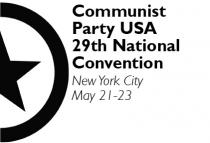 This article is part of the discussion leading up to the Communist Party USA’s 29th National Convention May 21-23, 2010. CPUSA.org takes no responsibility for the opinions expressed in this article or other articles in the pre-convention discussion. All contributions must meet the guidelines for discussion. To read other contributions to this discussion, visit the site of the Pre-Convention Discussion period.
This article is part of the discussion leading up to the Communist Party USA’s 29th National Convention May 21-23, 2010. CPUSA.org takes no responsibility for the opinions expressed in this article or other articles in the pre-convention discussion. All contributions must meet the guidelines for discussion. To read other contributions to this discussion, visit the site of the Pre-Convention Discussion period.
All contributions to the discussion should be sent to discussion2010@cpusa.org for selection not to the individual venues.For more information on the convention or the pre-convention discussion period, you can email convention2010@cpusa.org.
A look at the history of the CPUSA shows that its greatest growth and influence coincided with its development and expansion of a cadre of serious political actors.
Between 1927 and 1935 the cadre core that led the Party through the end of the century was formed and trained. This effort continued into the 1940’s, but, increasingly, training in Marxism became lax, and very few of the more than a million people that went through the Party between 1935 and 1947 remained.
The experience of the Trade Union Unity League (TUUL), which was the US affiliate of the Red International of Labor Unions (ProfIntern), created a critical mass core and a cadre core for the development of industrial unions, and then the CIO. That is to say, there would not (nay, could not) have been a CIO without the cadre that were developed in the previous decade through the TUUL-led organizing of industrial unions and leading and winning strike struggles. It should be noted that this happened under the leadership of the Communist International, although we are here focusing on the specifics of US phenomena.
In addition, the cadre core recruited and trained by the CPUSA and ComIntern led the Negro Liberation movement, conditioned the People’s (popular) front, and later, the civil rights movement and the movement against the US war on Viet Nam.
Every communist has an obligation to become the best Marxist and best revolutionary he or she can be, and every communist party has an obligation to facilitate that development. An organization that can play that role well is characterized by:
- a high level of theoretical development and political consciousness of each member
- a personal ethic of commitment to the struggle for proletarian power of each member
- commitment to self-cultivation and accountability at all levels of the party
- élan and efficiency of style of work at all levels of the party
The scientific and technological revolution has made mass production, in the sense of production involving masses of unskilled workers, and mass military formations obsolete. In the same way the mass party, consisting of unskilled activists managed by a small stratum of skilled leaders, is also obsolete.
Ironically, although the main discussion document says, “the days of a cadre party are over,” it acknowledges the need for such a party when it says, “we need a growing pool of dedicated leaders at every level.” The call for a “looser” organization and a social club atmosphere holds back the objective development of a modern party.
A cadre party is necessary now more than ever; and the new technologies facilitate its development. The advanced strata of the proletariat cannot be won without it. They are professional in their work and life habits. They expect professionalism in their political associations and actions. The amateurishness that has plagued our party for too long is an obstacle to our growth and development, particularly among this most advanced strata. Amateurishness and spontaneity, which dissipate the work of so many well-meaning members, can be overcome only in the context of building a serious, highly evolved, highly cultured, cadre party!


 Join Now
Join Now